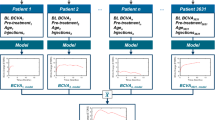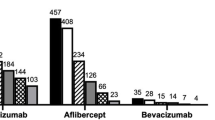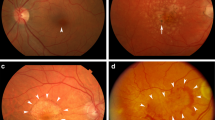Abstract
The standard of care treatment for neovascular age-related macular degeneration, delivered as ocular injection, is based on anti-vascular endothelial growth factor (anti-VEGF). The course of treatment may need to be modified quickly for certain patients based on their response. Models that track both the concentration and the response to an anti-VEGF treatment are presented. The specific focus is to assess the existence of analytical solutions for the different types of models. Both an ODE-based model and a map-based model illustrate the dependence of the solution on various biological parameters and allow the measurement of patient-specific parameters from experimental data. A PDE-based model incorporates diffusive effects. The results are consistent with observed values, and could provide a framework for practitioners to understand the effect of the therapy on the progression of the disease in both responsive and non-responsive patients.

Adapted from Blausencom staff (2014)

















Similar content being viewed by others
References
Awwad S, Lockwood A, Brocchini S, Khaw PT (2015) The PK-Eye: a novel in vitro ocular flow model for use in preclinical drug development. J Pharm Sci 104(10):3330–3342. https://doi.org/10.1002/jps.24480
Bekerman I, Gottlieb P, Vaiman M (2014) Variations in eyeball diameters of the healthy adults. J Ophthalmol 2014: 5
Bell W (1968) Special functions for scientists and engineers. Dover books on mathematics. D. Van Nostron, London
Bergmanson JPG, Martinez JG (2017) Size does matter: what is the corneo-limbal diameter? Clin Exp Optom 100(5):522–528
Blausen.com staff (2014) Medical gallery of Blausen Medical 2014. Wiki J Med. https://doi.org/10.15347/WJM/2014.010
del Amo EM, Rimpelä AK, Heikkinen E, Kari OK, Ramsay E, Lajunen T, Schmitt M, Pelkonen L, Bhattacharya M, Richardson D, Subrizi A, Turunen T, Reinisalo M, Itkonen J, Toropainen E, Casteleijn M, Kidron H, Antopolsky M, Vellonen KS, Ruponen M, Urtti A (2017) Pharmacokinetic aspects of retinal drug delivery. Prog Retin Eye Res 57:134–185. https://doi.org/10.1016/j.preteyeres.2016.12.001
Edington M, Connolly J, Chong NV (2017) Pharmacokinetics of intravitreal anti-VEGF drugs in vitrectomized versus non-vitrectomized eyes. Expert Opin Drug Metab Toxicol 13(12):1217–1224. https://doi.org/10.1080/17425255.2017.1404987
Falkenstein IA, Cheng L, Freeman WR (2007) Changes of intraocular pressure after intravitreal injection of bevacizumab (avastin). Retina 27(8):1044–1047. https://doi.org/10.1097/IAE.0b013e3180592ba6
Frenkel REP, Haji SA, La M, Frenkel MPC, Reyes A (2010) A protocol for the retina surgeon’s safe initial intravitreal injections. Clin Ophthalmol 4:1279
Gadkar K, Pastuskovas CV, Le Couter JE, Elliott JM, Zhang J, Lee CV, Sanowar S, Fuh G, Kim HS, Lombana TN, Spiess C, Nakamura M, Hass P, Shatz W, Meng YG, Scheer JM (2015) Design and pharmacokinetic characterization of novel antibody formats for ocular therapeutics. Investig Ophthalmol Vis Sci 56(9):5390–5400. https://doi.org/10.1167/iovs.15-17108
Hoyle D, Aslam TM (2017) Generative mathematical modelling to demonstrate virtual simulations of neovascular age related macular degeneration. PLoS ONE 12(12):1–12. https://doi.org/10.1371/journal.pone.0189053
Hutton-Smith LA, Gaffney EA, Byrne HM, Maini PK, Schwab D, Mazer NA (2016) A mechanistic model of the intravitreal pharmacokinetics of large molecules and the pharmacodynamic suppression of ocular vascular endothelial growth factor levels by ranibizumab in patients with neovascular age-related macular degeneration. Mol Pharm 13(9):2941–2950. https://doi.org/10.1021/acs.molpharmaceut.5b00849
Hutton-Smith LA, Gaffney EA, Byrne HM, Maini PK, Gadkar K, Mazer NA (2017) Ocular pharmacokinetics of therapeutic antibodies given by intravitreal injection: estimation of retinal permeabilities using a 3-compartment semi-mechanistic model. Mol Pharm 14(8):2690–2696
Kotha S, Murtomäki L (2014) Virtual pharmacokinetic model of human eye. Math Biosci 253:11–18. https://doi.org/10.1016/j.mbs.2014.03.014
Martínez-Cañada P, Morillas C, Pino B, Ros E, Pelayo F (2016) A computational framework for realistic retina modeling. Int J Neural Syst. https://doi.org/10.1142/S0129065716500301
McHugh KJ, Li D, Wang JC et al. (2019) Computational modeling of retinal hypoxia and photoreceptor degeneration in patients with age-related macular degeneration. PLoS ONE. https://doi.org/10.1371/journal.pone.0216215
Mulyukov Z, Weber S, Pigeolet E, Clemens A, Lehr T, Racine A (2018) Neovascular age-related macular degeneration: a visual acuity model of natural disease progression and ranibizumab treatment effect. CPT Pharmacomet Syst Pharmacol. https://doi.org/10.1002/psp4.12322
Rattanakijsuntorn K, Penkova A, Sadha SS (2018) Mass diffusion coefficient measurement for vitreous humor using FEM and MRI. IOP Conf Ser Mater Sci Eng 297:012024. https://doi.org/10.1088/1757-899x/297/1/012024
Roberts PA, Gaffney EA, Luthert PJ, Foss AJE, Byrne HM (2016) Mathematical and computational models of the retina in health, development and disease. Prog Retin Eye Res 53:48–69. https://doi.org/10.1016/j.preteyeres.2016.04.001
Schmidt-Erfurth U, Chong V, Loewenstein A, Larsen M, Souied E, Schlingemann R, Eldem B, Monés J, Richard G, Bandello F (2014) Guidelines for the management of neovascular age-related macular degeneration by the European Society of Retina Specialists (EURETINA). Br J Ophthalmol 98(9):1144–1167
Semeraro F, Morescalchi F, Duse S, Gambicorti E, Cancarini A, Costagliola C (2015) Pharmacokinetic and pharmacodynamic properties of anti-VEGF drugs after intravitreal injection. Curr Drug Metab 16(7):572–584. https://doi.org/10.2174/1389200216666151001120831
Wykoff CC, Clark WL, Nielsen JS, Brill JV, Greene LS, Heggen CL (2018) Optimizing anti-VEGF treatment outcomes for patients with neovascular age-related macular degeneration. J Manag Care Spec Pharm 24(2a Suppl):S3–S15. https://doi.org/10.18553/jmcp.2018.24.2-a.s3
Zhang Y, Bazzazi H, e Silva RL, Pandey NB, Green JJ, Campochiaro PA, Popel AS (2018) Three-dimensional transport model for intravitreal and suprachoroidal drug injection. Investig Ophthalmol Vis Sci 59(12):5266–5276
Acknowledgements
The authors would like to thank the reviewers for their helpful comments. The authors would like to thank Novartis (makers of two of the most successful anti-VEGF medicines) for (1) their interest in further developing models from first principles that can guide real world practices and for (2) sharing a small representative sample of BCVA and CSFT data that could guide the thinking expressed in this paper. The work in this manuscript arose out of the 2019 Mathematical Problems in Industry workshop, supported in part by National Science Foundation Grant DMS-1261592. Dr. Kiradjiev was partially supported by the EPSRC Centre For Doctoral Training in Industrially Focused Mathematical Modelling (EP/L015803/1).
Author information
Authors and Affiliations
Corresponding author
Additional information
Publisher's Note
Springer Nature remains neutral with regard to jurisdictional claims in published maps and institutional affiliations.
Appendix
Appendix
Parameter values from the literature are listed in Table 2, along with dimensionless parameters computed from our definitions. Here the subscripts “A” and “B” refer to two different medications with different dosage recommendations.
The value of \(k_C\) was calculated using the quoted value of a half-life of 9 days in Mulyukov et al. (2018). The values of \(\kappa \) were calculated using a time of 28 days between visits. The value of \(R_{\mathrm{l}}\) was calculated as a rough average of the measured values in Bergmanson and Martinez (2017). The values of \(R_{\mathrm{i}}\) and \(R_{\mathrm{i}}\) were chosen to maximize \(R_{\mathrm{d}}\). The value of \(D_{\mathrm{d}}\) was calculating using the treatment B dosage. The value of V is that for the vitreous fluid, not the entire eyeball.
Rights and permissions
About this article
Cite this article
Edwards, D.A., Emerick, B., Kondic, A.G. et al. Mathematical models for the effect of anti-vascular endothelial growth factor on visual acuity. J. Math. Biol. 81, 1397–1428 (2020). https://doi.org/10.1007/s00285-020-01544-4
Received:
Revised:
Accepted:
Published:
Issue Date:
DOI: https://doi.org/10.1007/s00285-020-01544-4
Keywords
- Pharmacokinetics
- Pharmacodynamics
- Analytical solutions
- Macular degeneration
- Diffusion equation
- Discrete modeling




